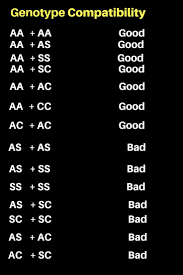AS genotype is also known as a carrier or sickle cell trait. It is when you have one normal gene and a sickle cell hemoglobin.
AS genotype is common. In Lagos State, Nigeria, about 24.5% of Yoruba people alone are AS.
Being an AS or a carrier doesn’t mean you will develop sickle cell disease However, marrying your fellow carrier will expose you to 25% chances of having a sickle cell baby.
Table of Contents
AS genotype symptoms
Just like other carriers, the AS genotype is not a sickness and they don’t show symptoms. However, they pass the trait to their offspring.
AS genotype and malaria.
Unlike people with genotype AA, AS hemoglobins are more resistant to malaria.
Although the reason is still unclear, studies have suggested it could be because of replacing the normal amino acid (glutamate) with an abnormal one.
For example, genotype AA is normal because it has glutamate at both ends of the globin chains.
Genotype AS: Has glutamate at position 6 of the 1st globin chain, and valine at position 6 of the 2nd globin chain.
Genotype SS: Has valine at position 6 of both globin chains.
We call this replacement of normal amino acid with abnormal ones thalassemia or hemoglobinopathy.
AS genotype crisis
Despite that, AS genes are carriers, it doesn’t mean they have sickle cells.
A crisis arises when two people with AS genes marry each other.
In such conditions, they will have a 25% chance of giving birth to a sickler.
Although some may be lucky to have up to six kids without a sickler, others may be unlucky as it will affect all their children.
Can genotype AS, and AA marry?
Yes, AS and AA are compatible. AS marrying AA will yield AA and AS offspring.
How often does the AS genotype fall sick?
This depends on the sickness. Anybody can get sick if infected.
However, people with AA genotype suffer malaria and typhoid more than others, which is because of their weaker immune systems.
Options for AS genotype couples
Couples with AS often face the challenge of playing around with sickle cell disease (SCD).
Although it’s never a bed of roses, still, some options await them. They include;
1. Prenatal genotype testing.
This is an act of testing the genotype of an unborn child for sickle cell anemia. The test analyzes the hemoglobin of the unborn child for abnormalities. For more details about the test, read here: Prenatal genotype testing.
2. In Vitro Fertilization (IVF):
IVF is an assisted fertility technique made for couples with pregnancy difficulties. It can also help AS couples have babies that are not SS.
IVF involves using the sperm or egg of a non-carrier (AA) to fertilize an egg in a test-tube before implanting the embryo into the mother.
3. Pre-implantation genetic diagnosis (PGD):
PGD is like IVF. It involves the fertilization of egg and sperm in a petri dish. They grow inside the dish for about 4 days before cell biopsy.
During a biopsy, non-sickler cells are transplanted to the mother, while SS is destroyed.
4. Adopt babies :
Couples with AS who don’t want to risk having a sickler should adopt babies. Although couples may face some stigmatization from their families, it is still better than having sickles.
5. Childless marriage:
While this may be a difficult option, some couples may still opt-in for it.
Childless marriages may still work for AS couples that don’t want babies.
Can AS genotype change to AA?
No, AS can never change to AA. It is only a misinterpretation of results that can yield to such change.
What are the AS genotype compatibles?
AS is compatible with AA genotype only.
Bottom line
You have seen all you need to know about AS hemoglobin. Their compatible options for AS couples and many more.
It’s left for you to make your choice. However, marrying a non-carrier is always the best option than passing through difficulties.
